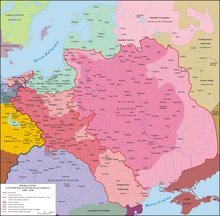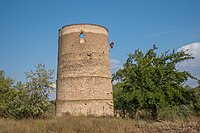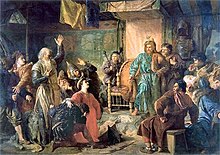Vytautas
| Vytautas the Great | |
|---|---|
Grand Duke of Lithuania | |
| Reign | 4 August 1392 – 27 October 1430 |
| Predecessor |
|
| Successor | Švitrigaila |
| Born | c. 1350 Senieji Trakai, Grand Duchy of Lithuania |
| Died | 27 October 1430 (aged 79–80) Trakai, Grand Duchy of Lithuania |
| Burial | |
| Spouse | |
Kęstutis | |
| Father | Kęstutis |
| Mother | Birutė |
Vytautas (c. 1350 – 27 October 1430), also known as Vytautas the Great[1] (Lithuanian: ⓘ, Belarusian: Вітаўт, Vitaŭt,[2] Polish: Witold Kiejstutowicz, Witold Aleksander or Witold Wielki,[1] Ukrainian: Вітовт (Vitovt), Ruthenian: Витовт (Vitovt), Latin: Alexander Vitoldus, Old German: Wythaws or Wythawt)[3] from the late 14th century onwards, was a ruler of the Grand Duchy of Lithuania. He was also the prince of Grodno (1370–1382), prince of Lutsk (1387–1389), and the postulated king of the Hussites.[4]
In modern Lithuania, Vytautas is revered as a national hero and was an important figure in the national rebirth in the 19th century. Vytautas is a popular male given name in Lithuania. In commemoration of the 500-year anniversary of his death, Vytautas Magnus University was named after him. Monuments in his honour were built in many towns in independent Lithuania during the interwar period from 1918 to 1939. Vytautas knew and spoke the Lithuanian language with his cousin Jogaila.[5][6][7]
Struggle for power
1377–1384
Vytautas' uncle
In 1382, Vytautas escaped from Kreva and he sought help from the Teutonic Order, who were negotiating with Jogaila at the time. Jogaila and the Order agreed to the
1385–1392

In 1385, Jogaila concluded the Union of Krewo with Poland, under which he married Jadwiga of Poland and became King of Poland as Władysław II Jagiełło. Vytautas participated in the Union and in 1386 was re-baptised as a Catholic, receiving the name Alexander. In 1386 Vytautas paid homage to Jagiello, after his coronation to the king of Poland.[8]
Jogaila left his brother
The Polish nobles were unhappy that their new king spent too much time on Lithuanian affairs. It was clear that the war could continue for years and would not benefit Poland. In 1392, Jogaila sent
Grand Duke of Lithuania
Policy towards the East
Vytautas continued Algirdas' vision to control as many Ruthenian lands as possible. Much of the territory was already under the Grand Duke's rule, but the rest was controlled by the Mongols. Tokhtamysh, Khan of the Golden Horde, sought help from Vytautas when he was removed from the throne in 1395 after his defeat by Timur. An agreement was reached that Vytautas would help Tokhtamysh to regain power, and the Horde would cede more lands to the Grand Duchy of Lithuania in return. In 1398, Vytautas' army attacked a part of the Crimea and built a castle there. Now Lithuania spanned from the Baltic Sea to the Black Sea. A number of Tatar captives were brought to ethnic Lithuania.
Continuing attempts on the part of Poland to subordinate Lithuania drove Vytautas for the third time into the arms of the Order, and by the Treaty of Salynas in October 1398, Vytautas, who now styled himself Supremus Dux Lithuaniae, ceded his ancestral province of Samogitia to the knights, formed an alliance with them for the conquest and partition of Pskov and Novgorod the Great.[9]

Inspired by his successful campaign against Timur, Vytautas and Jogaila won support from
Wars against the Teutonic Order
"We do not know on whose merits or guilt such a decision was made, or with what we have offended Your Lordship so much that Your Lordship has deservedly been directed against us, creating hardship for us everywhere. First of all, you made and announced a decision about the land of Samogitia, which is our inheritance and our homeland from the legal succession of the ancestors and elders. We still own it, it is and has always been the same Lithuanian land, because there is one language and the same inhabitants. But since the land of Samogitia is located lower than the land of Lithuania, it is called as Samogitia, because in Lithuanian it is called lower land [ Žemaitija ]. And the Samogitians call Lithuania as Aukštaitija, that is, from the Samogitian point of view, a higher land. Also, the people of Samogitia have long called themselves as Lithuanians and never as Samogitians, and because of such identity (sic) we do not write about Samogitia in our letter, because everything is one: one country and the same inhabitants."
—

In the
In 1408, Vytautas reached peace in the east and returned to Samogitian matters. In 1409 the second
As a result of the
Relationship with Poland
In 1399

Vytautas was one of the creators of the Union of Horodło with Poland in 1413. According to the act of the union, the Grand Duchy of Lithuania was to retain a separate Grand Duke and its own parliament. At the same time both the Polish and Lithuanian Sejms were to discuss all the important matters jointly. This union was important culturally as well as politically because it granted Lithuanian Christian nobles the same rights as the Polish szlachta. This act did not include Orthodox nobles. This paved the way for more contacts and cooperation between the nobles of Poland and of Lithuania.
In January 1429, at the
According to the Encyclopædia Britannica Eleventh Edition, Vytautas "was certainly the most imposing personality of his day in Eastern Europe, and his martial valour was combined with statesmanlike foresight."

Reforms
Vytautas backed the economic development of his state and introduced many reforms. Under his rule the Grand Duchy of Lithuania gradually became more centralised, as local princes with dynastic ties to the throne were replaced by the governors loyal to Vytautas. The governors were rich landowners who formed the basis for the Lithuanian nobility. During Vytautas' rule, the influential Radvila (
In 1398, Vytautas brought over families of the Karaim (388 families) and Tatar peoples. Their principal role was to guard the castle and the bridges, but they also served as translators, farmers, traders, and diplomats. He retains a very high reputation among them, with the anniversary of his death being officially celebrated in 1930 in the kenesa in Vilnius.[17]
Family
Born in 1350 in the
Depictions

A sculpture for Vytautas is display on the Millennium of Russia monument in Veliky Novgorod.
Vytautas appears in several works of fiction dealing with the Polish-Lithuanian conflict with the Teutonic Order. He appears in the narrative poem Konrad Wallenrod by Adam Mickiewicz. He was portrayed by Józef Kostecki in Knights of the Teutonic Order, the 1960 adaptation of the famous novel by Henryk Sienkiewicz.
In 2014, a short animation was produced by "Four Directions of Fairy Tales" (Cztery Strony Bajek) in association with the Association of Polish Karaims, portraying the Karaim story of Vytautas and his magic horse, with voiceovers in several languages, including Karaim, Polish, English, and Lithuanian.[20]
In the video game Age of Empires II: Definitive Edition, Vytautas featured as a cavalry hero.
Vytautas is also mentioned in Jonathan Franzen's fictitious novel "The Corrections", which attributes his death in 1430 to Lithuania's gradual downfall as a "global player".[citation needed]
See also
- Gediminids
- House of Kęstutis– family tree of Vytautas
- Order of Vytautas the Great
Notes
- ^ a b "Vytautas the Great". Encyclopædia Britannica. Retrieved 16 February 2019.
- ^ Vitaŭt in: Historical Dictionary of Belarus, Scarecrow Press, London 1998.
- ISBN 9789637326585.
- ISBN 1-84176-665-8.
- 15min.lt(in Lithuanian). Retrieved 1 October 2014.
- ^ Statkuvienė, Regina. "Jogailaičiai. Kodėl ne Gediminaičiai?". 15min.lt (in Lithuanian). Retrieved 9 November 2018.
- 15min.lt(in Lithuanian). 20 November 2021.
- ^ Henryk Łowmiański (1999). Polityka Jagiellonów. Poznań: Wydawnictwo Poznańskie, p.59-60, ISBN 83-7177-104-5
- ^ a b c d One or more of the preceding sentences incorporates text from a publication now in the public domain: Bain, Robert Nisbet (1911). "Witowt". In Chisholm, Hugh (ed.). Encyclopædia Britannica. Vol. 28 (11th ed.). Cambridge University Press. p. 762.
- ISBN 83-06-01796-X.
- ^ Tekla Wołowska (1860). Historya Polska (Polish History) (in Polish). Paris: L. Martinet. p. 433.
- Akademia Umiejętności. p. 240.
- Vytautas the Great; Valkūnas, Leonas (translation from Latin). Vytauto laiškai [ Letters of Vytautas the Great ] (PDF) (in Lithuanian). Vilnius University, Institute of Lithuanian Literature and Folklore. p. 6. Retrieved 9 May 2021.
- DELFI(in Lithuanian). Retrieved 9 May 2021.
- ^ "Aukštaitija". Ekgt.lt (in Lithuanian). Etninės kultūros globos taryba (Council for the Protection of Ethnic Culture). Retrieved 9 May 2021.
- ^ Frost 2015, p. 148
- ^ "Guide to Trakai Historical National Park" (PDF) (in Polish). Retrieved 9 December 2014.
- ^ Narbutt, Teodor (1847). Dzieje starożytne narodu litewskiego. Vilnius. pp. 562–3.
- ^ a b Tęgowski, Jan (1999). Pierwsze pokolenie Giedyminowiczów. Poznań-Wrocław: Wydawnictwo Historyczne.
- ^ English version on youtube: https://www.youtube.com/watch?v=PpGQ5USWVOA
References
- (in Lithuanian) Inga Deidulė, Vytauto Didžiojo įvaizdžio genezės mįslė, – "ieškokite moterų", Vartiklis. Accessed 20 May 2006.
- (in Lithuanian) Andrius Mingėla, Vytautas Lietuvos didysis kunigaikštis, Juventa high school. Accessed 20 May 2006.
- Oscar Halecki, Borderlands of Western Civilization: A History of East Central Europe, 2nd edition, Chapter 8, Simon Publications, July 2001, ISBN 0-9665734-8-X
- Vytautas and Karaims, Lithuanian Karaims Culture Community. Accessed 20 May 2006.
